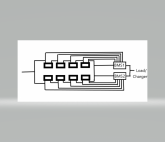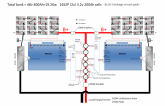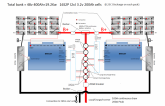@Solarfun4jim. I think the wiring you show may not be correct. I do not have direct experience with chargery but I have read the manual (a few times). The instructions on the relay delay controller are not very clear, but he key for me was this line in the instructions:
" When large current relay closed, the small relay will be open automatically according to the below connection diagram."
I *think* this is the way it would be wired if you have an All-In-One:
View attachment 5356
Notice that the small discharge relay is not in series with the large discharge relay, instead it creates a bypass to the large discharge relay.
Note: My diagram is for a single BMS. You would put two sets of these in series for two BMSs. However, you could also rearrange the circuit to use a single discharge resistor like this:
View attachment 5358
With a couple of diodes, this can be further simplified:
View attachment 5360
Note: The flyback diode that is mentioned below would work for these diodes.
With this, the signals for the small discharge relays are "OR'd" (If either one OR the other of the signals are on, the relay turns on). (The diodes are probably not be necessary, but I would need to see the circuit of the delay board to say for sure.)
I am still pondering the best way to combine the Large Discharg relays and the Charge relays. Conceptually, 'all' you have to do is "AND" all four signals to drive one relay. If I come up with a circuit I like, I'll post it here.
One more thing: All the relays should have a flyback diode across the coil Here are some comments from
Will's latest video that describes it.
Comments below suggested the use of a "Flyback Diode". Very smart idea!! This is how they work: More information: https://en.wikipedia.org/wiki/Flyback_diode I will update my schematic for this change. Brian B put it nicely in a comment below: Great content! One way to stop shocking yourself and possibly damaging you BMS, put a large diode in the opposite direction across the coil. ie negative of the diode will go to the positive coil terminal and positive of the diode to negative terminal. This is called a 'fly back' diode. And here is another super useful comment by foxabilo edited) You can fit a simple diode (1N4001) pointing from the negative relay terminal to the positive relay terminal (diode band towards the positive), - ----->|----- + which will stop the shocking voltage, you can also place a suitably rated capacitor across the terminals to further dampen down fast transient voltages. (ensure it's voltage rating is higher than the maximum voltage of your system) And here is a non-sponsored link to this diode: https://www.amazon.com/100PCS-1N4001-Rectifier-Diode-DO-204AL/dp/B07YYLQFFK/ref=sr_1_2_sspa?keywords=1N4001&qid=1579202678&sr=8-2-spons&psc=1&spLa=ZW5jcnlwdGVkUXVhbGlmaWVyPUEzSDZaS0ZEWjVFODJEJmVuY3J5cHRlZElkPUEwNDI1MDI5MkNBWjAwMlk4SUk3RSZlbmNyeXB0ZWRBZElkPUEwODIxNzY1VUxKNk9JTExGSUtOJndpZGdldE5hbWU9c3BfYXRmJmFjdGlvbj1jbGlja1JlZGlyZWN0JmRvTm90TG9nQ2xpY2s9dHJ1ZQ==
edited) You can fit a simple diode (1N4001) pointing from the negative relay terminal to the positive relay terminal (diode band towards the positive), - ----->|----- + which will stop the shocking voltage, you can also place a suitably rated capacitor across the terminals to further dampen down fast transient voltages. (ensure it's voltage rating is higher than the maximum voltage of your system) And here is a non-sponsored link to this diode: https://www.amazon.com/100PCS-1N4001-Rectifier-Diode-DO-204AL/dp/B07YYLQFFK/ref=sr_1_2_sspa?keywords=1N4001&qid=1579202678&sr=8-2-spons&psc=1&spLa=ZW5jcnlwdGVkUXVhbGlmaWVyPUEzSDZaS0ZEWjVFODJEJmVuY3J5cHRlZElkPUEwNDI1MDI5MkNBWjAwMlk4SUk3RSZlbmNyeXB0ZWRBZElkPUEwODIxNzY1VUxKNk9JTExGSUtOJndpZGdldE5hbWU9c3BfYXRmJmFjdGlvbj1jbGlja1JlZGlyZWN0JmRvTm90TG9nQ2xpY2s9dHJ1ZQ==












